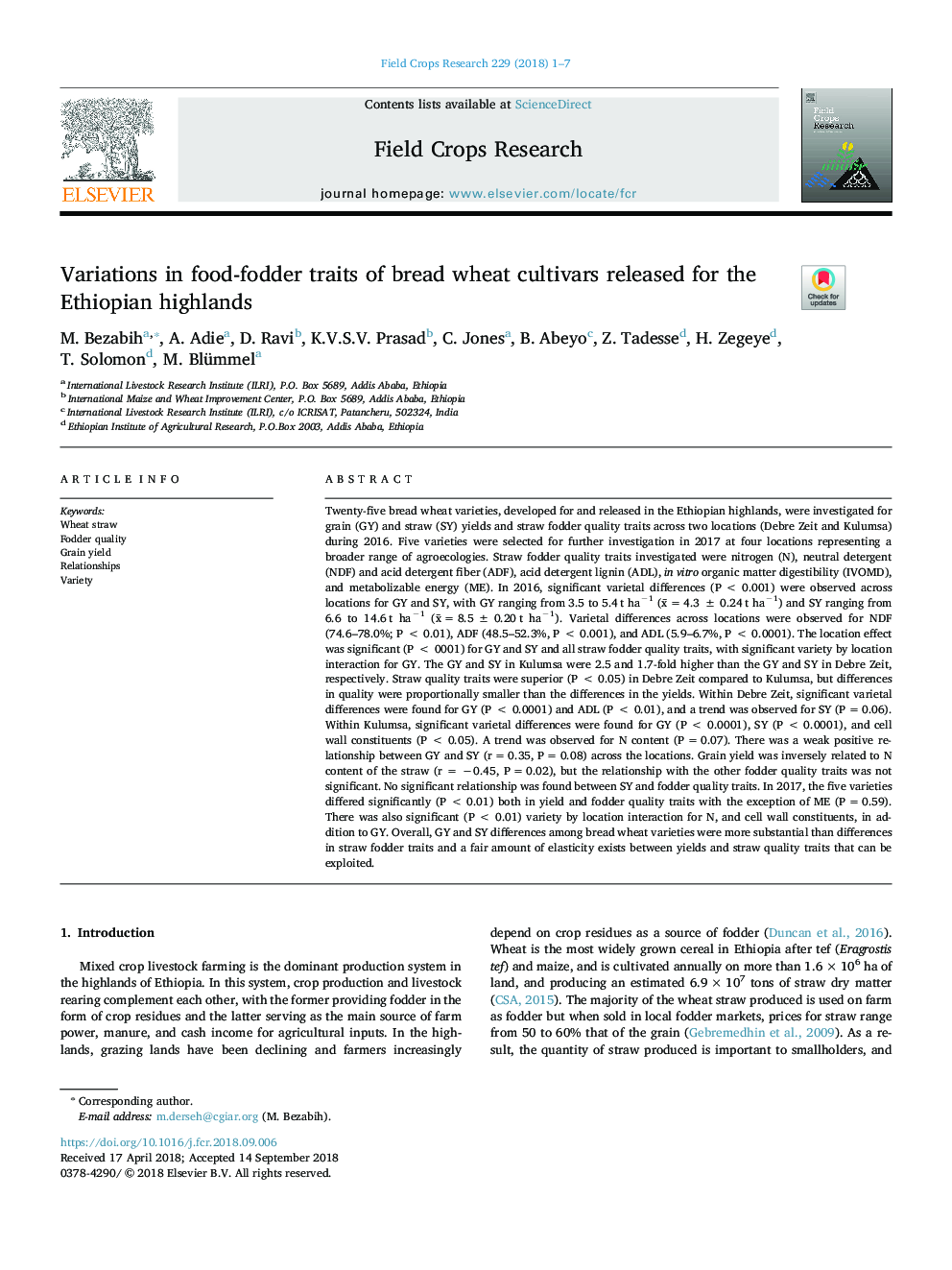| کد مقاله | کد نشریه | سال انتشار | مقاله انگلیسی | نسخه تمام متن |
|---|---|---|---|---|
| 10223753 | 1701051 | 2018 | 7 صفحه PDF | دانلود رایگان |
عنوان انگلیسی مقاله ISI
Variations in food-fodder traits of bread wheat cultivars released for the Ethiopian highlands
ترجمه فارسی عنوان
تنوع خواص خوراکی علوفه ارقام گندم نان برای سرزمین های اتیوپی منتشر شد
دانلود مقاله + سفارش ترجمه
دانلود مقاله ISI انگلیسی
رایگان برای ایرانیان
کلمات کلیدی
کاه گندم، کیفیت علوفه، عملکرد دانه، روابط، تنوع،
موضوعات مرتبط
علوم زیستی و بیوفناوری
علوم کشاورزی و بیولوژیک
علوم زراعت و اصلاح نباتات
چکیده انگلیسی
Twenty-five bread wheat varieties, developed for and released in the Ethiopian highlands, were investigated for grain (GY) and straw (SY) yields and straw fodder quality traits across two locations (Debre Zeit and Kulumsa) during 2016. Five varieties were selected for further investigation in 2017 at four locations representing a broader range of agroecologies. Straw fodder quality traits investigated were nitrogen (N), neutral detergent (NDF) and acid detergent fiber (ADF), acid detergent lignin (ADL), in vitro organic matter digestibility (IVOMD), and metabolizable energy (ME). In 2016, significant varietal differences (Pâ<â0.001) were observed across locations for GY and SY, with GY ranging from 3.5 to 5.4ât haâ1 (xÌâ=â4.3â±â0.24ât haâ1) and SY ranging from 6.6 to 14.6ât haâ1 (xÌâ=â8.5â±â0.20ât haâ1). Varietal differences across locations were observed for NDF (74.6-78.0%; Pâ<â0.01), ADF (48.5-52.3%, Pâ<â0.001), and ADL (5.9-6.7%, Pâ<â0.0001). The location effect was significant (Pâ<â0001) for GY and SY and all straw fodder quality traits, with significant variety by location interaction for GY. The GY and SY in Kulumsa were 2.5 and 1.7-fold higher than the GY and SY in Debre Zeit, respectively. Straw quality traits were superior (Pâ<â0.05) in Debre Zeit compared to Kulumsa, but differences in quality were proportionally smaller than the differences in the yields. Within Debre Zeit, significant varietal differences were found for GY (Pâ<â0.0001) and ADL (Pâ<â0.01), and a trend was observed for SY (Pâ=â0.06). Within Kulumsa, significant varietal differences were found for GY (Pâ<â0.0001), SY (Pâ<â0.0001), and cell wall constituents (Pâ<â0.05). A trend was observed for N content (Pâ=â0.07). There was a weak positive relationship between GY and SY (râ=â0.35, Pâ=â0.08) across the locations. Grain yield was inversely related to N content of the straw (r = â0.45, Pâ=â0.02), but the relationship with the other fodder quality traits was not significant. No significant relationship was found between SY and fodder quality traits. In 2017, the five varieties differed significantly (Pâ<â0.01) both in yield and fodder quality traits with the exception of ME (Pâ=â0.59). There was also significant (Pâ<â0.01) variety by location interaction for N, and cell wall constituents, in addition to GY. Overall, GY and SY differences among bread wheat varieties were more substantial than differences in straw fodder traits and a fair amount of elasticity exists between yields and straw quality traits that can be exploited.
ناشر
Database: Elsevier - ScienceDirect (ساینس دایرکت)
Journal: Field Crops Research - Volume 229, 1 December 2018, Pages 1-7
Journal: Field Crops Research - Volume 229, 1 December 2018, Pages 1-7
نویسندگان
M. Bezabih, A. Adie, D. Ravi, K.V.S.V. Prasad, C. Jones, B. Abeyo, Z. Tadesse, H. Zegeye, T. Solomon, M. Blümmel,
